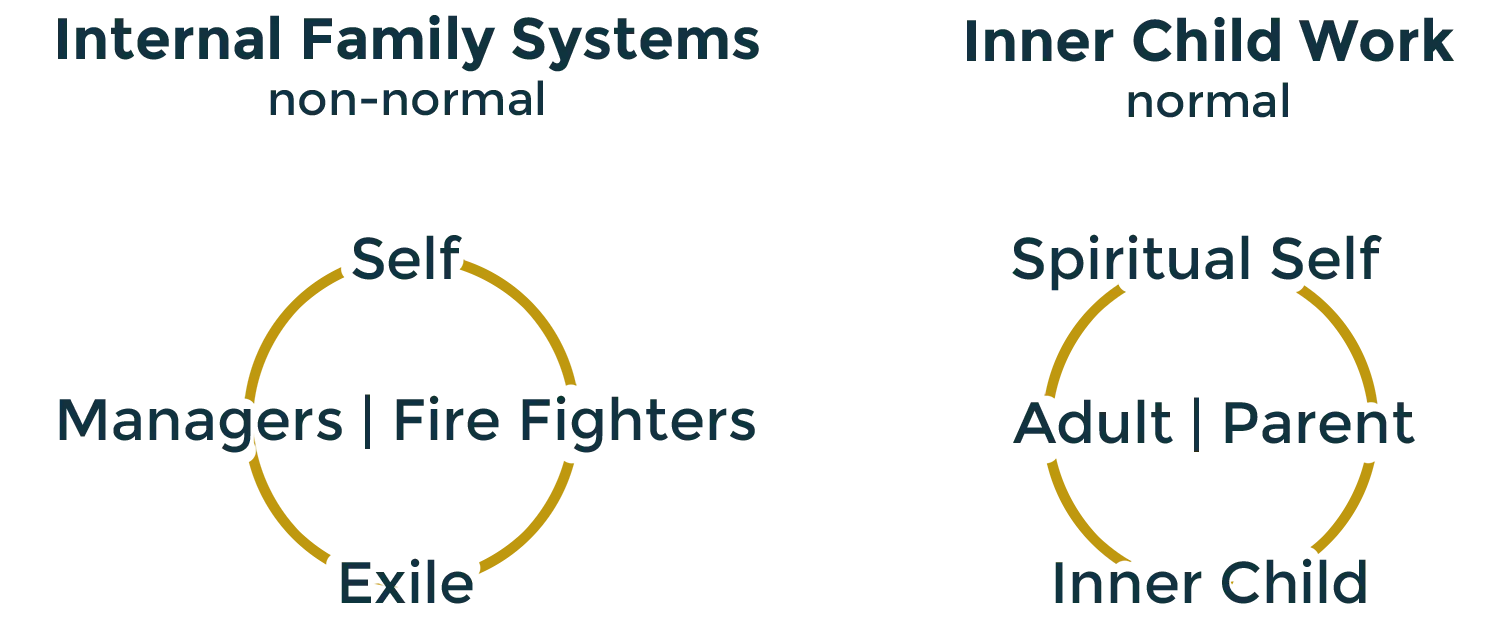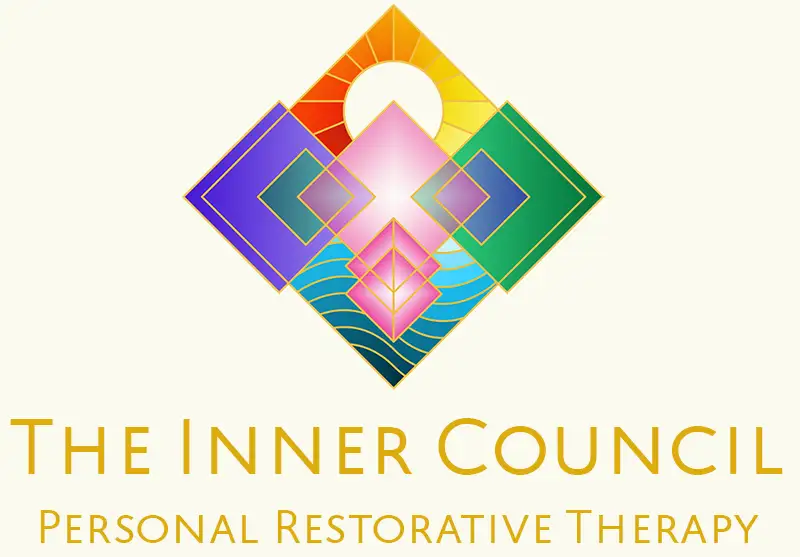The following article is to address questions we receive about inner child and IFS compatibility and comparisons. At the Inner Council we have a slightly different viewpoint as our inner child work is more focused on long term practice through self-therapy, however, we do support practitioners to use our work in the traditional therapeutic setting for short term integration methods. We hope to give guidance for those who are assessing their individual needs to make the best personal choices.
Inner Child Work and IFS Internal Family Systems
From the get go, we want to explain that IFS is a clinical only practice for non-normal situations. Inner Child work can bridge the gap between clinical therapy and personal therapy, where a client is in a more favourable position, a safe environment and an enthusiastic approach to rediscover an internal relationship. In this way, we can see that both IFS and Inner Child work have a similar framework for representing different parts of the self. Inner Child work assumes a normal placement of well functioning roles, whereas IFS may be assuming an emergency response to non-normal circumstances.

The Essence of Inner Child Work
In many modern interpretations, Inner Child Work is treated as a brief emotional practice, a way to reconnect with our innocence or soothe a hurt feeling. But in its deeper form, this work is not simply about comfort; it is about guardianship. The adult self becomes the caretaker of the child within, not for a single session, but as a lifelong commitment.
The “inner child” represents more than a psychological imprint; it is a living current of consciousness that remembers how to love, trust, and feel. When that current is abandoned, we lose not only emotional vitality but the spiritual continuity of who we are.
To begin Inner Child Work is therefore to recover the responsibilities of guardianship, to become the parent, witness, and protector that the child once needed. Over time, this relationship matures into a quiet trust. The child begins to reveal not only its wounds but its wisdom, its spontaneous joy, and its sense of connection to life itself.
In this sense, Inner Child Work is not only therapeutic but initiatory, establishing a path through which the Self learns what it means to love responsibly. The inner child becomes both student and teacher, guiding the adult toward a rebirth of tenderness and presence.
Example:
A man who always feels detached from joy begins to imagine sitting beside his six-year-old self each morning. At first, the child is wary, accustomed to being ignored. But as the adult continues to show up, listening without trying to fix, something changes. The child begins to speak again, not in words but in sensations, a bubbling of excitement, a sense of safety, a small willingness to play. Over weeks and months, this becomes a dialogue of trust, not a single catharsis.
The Structure of Internal Family Systems (IFS) Therapy
By contrast, Internal Family Systems (IFS) approaches the psyche as a system of interrelated parts, each with distinct roles and protective intentions. These parts are often categorised into Managers, Firefighters, and Exiles, representing how the mind organizes itself around pain and protection.
- Managers try to control life to prevent hurt.
- Firefighters react impulsively when pain breaks through, through anger, addiction, distraction, or withdrawal.
- Exiles hold the deep wounds and burdens of the past.
At the center of this system is the Self, a calm, compassionate, aware presence that can witness and lead the inner system without judgment. The goal of IFS therapy is to help the Self reestablish leadership, bringing understanding and integration to each part. IFS blends mindfulness and compassion, helping us build inner relationships rather than suppressing or bypassing painful emotions.
Example:
A man recognises that part of him constantly criticises his own work. In IFS, this “inner critic” is understood as a Manager trying to keep him safe from the humiliation he once felt as a child. When he approaches it with curiosity instead of resistance, another layer, an Exile, emerges: a younger self who was scolded for small mistakes. By comforting that younger part, the critic’s intensity softens.
How Inner Child work and IFS can work together
When we view Inner Child Work through this lens of ongoing guardianship, its relationship to IFS becomes even more interesting. IFS provides the map of the inner system, the logic of how different parts protect or exile each other. Inner Child Work, as you practice it, provides the continuing relationship that sustains that system’s healing over time. While IFS might help you identify that an Exile holds early pain, Inner Child Work keeps the connection alive after the discovery. It asks: “How do I live daily with this younger self? How do I build enough trust that this part knows I will never abandon it again?”
Example:
After an IFS session reveals a frightened, isolated child part, a woman chooses to begin an ongoing morning ritual, lighting a candle and speaking a few kind words to her inner child. Over weeks, she feels less reactive and more stable. What began as an IFS insight becomes a living practice of presence, a relationship that breathes.
IFS has an established therapeutic framework with clear roles for parts and an emphasis on Self leadership and unburdening. It’s widely used in trauma-informed therapy and has evidence supporting effectiveness for a range of issues. Inner-child approaches derive from psychodynamic and humanistic traditions (e.g., object relations, attachment theory, reparenting models) and emphasize emotional attunement, corrective relational experiences, and embodiment.
In this way, IFS can open the door, and Inner Child Work can help us stay in the room.
The Inner Child as the Facilitator of Healing
The deeper one travels into Inner Child Work, the clearer it becomes that the child is not merely the recipient of healing but the facilitator of it. The child embodies the bridge between the human and the spiritual, between experience and essence. When the adult self consistently offers guardianship, showing up day after day, listening, protecting, and nurturing, the child begins to awaken as a kind of inner guide. It brings forward the qualities of wonder, faith, and sensitivity that the adult may have long forgotten. This renewed relationship can sometimes feel like a spiritual birth: a sense that something ancient within you is being reawakened, something that was never truly lost but only hidden beneath years of survival. Healing is not the child becoming grown, nor the adult becoming young again, it is the reunion of the two, so that wisdom and innocence can exist side by side. The adult offers protection; the child offers light. Together, they restore the inner ecology of love.
Integrating the Two Approaches
Both IFS and Inner Child Work invite us to remember that the psyche is not broken, only fragmented in its attempt to stay safe. Healing, in either model, is not about becoming someone new but becoming whole again. When we meet our inner child, we are not regressing; we are returning to the place where love was interrupted. And when we approach our parts with curiosity and compassion, as IFS teaches, we rediscover the innate harmony that has always been within us. When the adult self learns to remain in guardianship, and the inner child learns that it will not be left again, a subtle alchemy occurs, the system no longer lives in trauma time. It begins to live in trust.
A blended approach might look like this:
- Begin with IFS mapping — identify the parts currently active (the perfectionist, the avoider, the worrier).
- Notice any younger energy associated with one of those parts.
- Shift into Inner Child dialogue — speak to that younger self, not as a therapist but as a loving adult presence.
- Return to the IFS system to check how other parts respond to this healing.
This integration allows both structure and softness, reason and reverence. The goal isn’t to fix the child or the parts but to build relationship, the heart of all healing.
“The wound is the place where the Light enters you.” — Rumi
When to Choose Inner Child Work or IFS
Both approaches can be powerful, but they serve slightly different needs.
Inner Child Work may be best suited when you:
- Feel emotionally disconnected or long to restore tenderness.
- Seek healing through imagery, journaling, or somatic reconnection.
- Want to reparent yourself in a nurturing, heart-led way.
- Are able to learn a set of tools to help you make positive changes.
IFS Therapy may be best suited when you:
- Notice internal conflict (e.g. “part of me wants this, part of me resists”).
- Need structure to navigate trauma safely.
- Want to understand how protective patterns interact and evolve.
- Need external support to understand what’s happening.
Conclusion
IFS and Inner Child Work both open pathways toward wholeness, yet they differ in depth and duration. IFS is a therapeutic framework, a structured, guided process that helps us safely meet the complexity of our inner world. It can reveal where pain has been stored, how our parts protect us, and how the Self can bring calm leadership to inner chaos. But IFS, by design, is temporary. It is a map, not a home. It helps us stabilise and see, but it does not itself sustain the ongoing relationship that healing ultimately requires.
Inner Child Work, as we understand it, begins where therapy ends. It is not a session, but a way of living. It invites us to become the guardian of our own innocence, to take up the daily responsibility of care that no therapist can provide. A practitioner can guide you toward your inner child, but they cannot build the trust, intimacy, and spiritual continuity that only you can create through consistent presence.
In this sense, IFS may illuminate the architecture of the psyche, while Inner Child Work restores the soul’s ecology. Over time, this relationship between adult and child ripens into something sacred, a reunion of the protector and the light, the wisdom and the wonder. This is the quiet alchemy of healing: the Self reborn through love, the child finally safe to lead us home.
The Inner Council provide both Inner Child Workshops and Inner Child Certified Practitioner training.
Would you like to have a conversation to help you decide?
We are always available to discuss the work that we provide and to explain, through examples, the process that we witness in others. If you have questions, please contact us and arrange a call.

